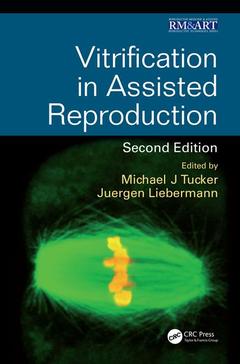Vitrification in Assisted Reproduction (2nd Ed.) Reproductive Medicine and Assisted Reproductive Techniques Series
Coordonnateurs : Tucker Michael, Liebermann Juergen

Vitrification in Assisted Reproduction presents standard and new cryopreservation techniques in detail, outlining those that have resulted in success, and providing recommended means for overcoming typically encountered problems.
This new edition provides a much broader range of clinical application and data to demonstrate its contribution to the use of vitrified oocytes and embryos. The book also discusses new areas in the field of assisted reproductive technology such as oocyte banking, preimplantion diagnostics at the blastocyst stage, and the burgeoning adoption of elective single embryo transfer.
Written by expert scientists and clinical embryologists, this book will help you to consistently and predictably apply vitrification as an important therapeutic strategy in assisted reproduction.
Overview of Biological Vitrification. Vitrification of Oocytes and Embryos: Finally a Recognized Technique, But Still a Source of Concern and Debate. Intracellular Concentration of Cryoprotectant During Vitrification and Slow-Freezing Cryopreservation Procedures? Importance of Cooling Versus Warming Rates in Vitrification Techniques. The Movement of Water and Cryoprotectants in Mammalian Oocytes and Embryos: Membrane Permeability and Aquaporins. Open Versus Closed Systems. Automatic Vitrification: Development of the Gavi System. Vitrification at Minimum Volume: From Basic Science to Clinical Application. Vitrification of Oocytes: General Considerations and the Use of the Cryotec Method. Safety of Vitrification and Cryostorage and Optimization of Cryopreservation Protocols. Physiological Aspects of Oocyte Vitrification. Vitrification of Oocytes: Imprinting and Disturbance in Spindle Formation and Chromosome Segregation. Metabolic Profile of Day 3 Embryos Arising from Vitrified Oocytes. Vitrification of Human Oocytes for In Vitro Fertilization Patients. Oocyte Vitrification: Donor "Egg Banking." Fertility Preservation for oncology Patients. Vitrification of Human Ovarian Tissue. Vitrification of Cleavage-Stage Embryos and Blastocysts and Their Neonatal Outcomes. Vitrification of Human Blastocysts: Clinical Realities and Neonatal Outcomes. Development and Hatching of Human Blastocysts After Vitrification and Warming. Does Storage of Vitrified Blastocysts Have an Impact on Implantation Potential and Birth Rate? Ovarian Tissue Vitrification: Clinical Realities and Outcomes Chapter for From Basic Science to Clinical Application. Vitrification of Human Testicular Tissue, Spermatogonia, and Spermatozoa. Vitrification in Pluripotent Stem Cell Banking: Requirements and Technical Solutions For Large-Scale Biobanks. Scrying The Future: The ongoing Transformation of Reproductive Medicine Through Vitrification.
Edited by
Michael J. Tucker, PhD, HCLD, FI Biol., is scientific director at Georgia Reproductive Specialists in Atlanta, and Director of IVF laboratories at Shady Grove Fertility in the mid-Atlantic region of the USA. He earned a doctorate in reproductive physiology from the University of Birmingham in the UK, and is a fellow of The Royal Institute of Biology. Dr. Tucker pioneered the first intracytoplasmic sperm injection (ICSI) birth in the United States, the nation's first birth resulting from a testicular biopsy, the world's first birth from frozen donor eggs, and the first pregnancy in the world from immature eggs that were matured after thawing in the IVF lab. His current research interests include pre-implantation genetic diagnosis, oocyte and embryo cryopreservation, extended embryo growth and selection, and gamete/embryo micromanipulation. He has authored numerous peer review papers and chapters over the last 30years, and has served as a scientific consultant and lecturer in more than 50 clinics worldwide.
Juergen Liebermann PhD, HCLD (ABB),is certified as a High-complexity Clinical Laboratory Director through the American Board of Bioanalysis. Dr. Liebermann has been working in the field of IVF since 1995. He is the laboratory director for FCI's Chicago/River North Embryology Lab, all FCI Andrology Labs, and the Endocrinology Lab. In his role as director of the Embryology Laboratory, he works with eggs, semen and embryos performing various procedures such as in vitro fertilization, egg vitrification, semen analysis, embryo selection for treatment, intracytoplasmic sperm injection and preimplantation diagnostic and screening of human embryos. Dr. Liebermann’s postdoctoral thesis in 2004 qualified him as a university lecturer in Experimental Reproductive Medicine at the Bavarian University of Wuerzburg, Germany. He is a member of the American Society for Reproductive Medicine, the Euro
Date de parution : 10-2015
17.8x25.4 cm
Disponible chez l'éditeur (délai d'approvisionnement : 15 jours).
Prix indicatif 208,65 €
Ajouter au panierThèmes de Vitrification in Assisted Reproduction :
Mots-clés :
Oocyte Cryopreservation; Vitried Oocytes; Vitrification; Donor Egg Banking; ART; Vitrication Solution; Cryopreservation; Slow Freezing; Oocyte Vitrification; Spindle Integrity; Aer Vitrication; Vitried Blastocyst; FP; Meiotic Spindle; Embryo Cryopreservation; MII Oocyte; Aer Warming; Vitrication Protocol; Mouse Oocytes; Human Oocytes; Cooling Rate; Fresh Oocyte; Fresh Embryo Transfer; Ovarian Tissue; PGD; Pre-implantation Genetic Diagnosis; Et; Blastocyst Transfer



